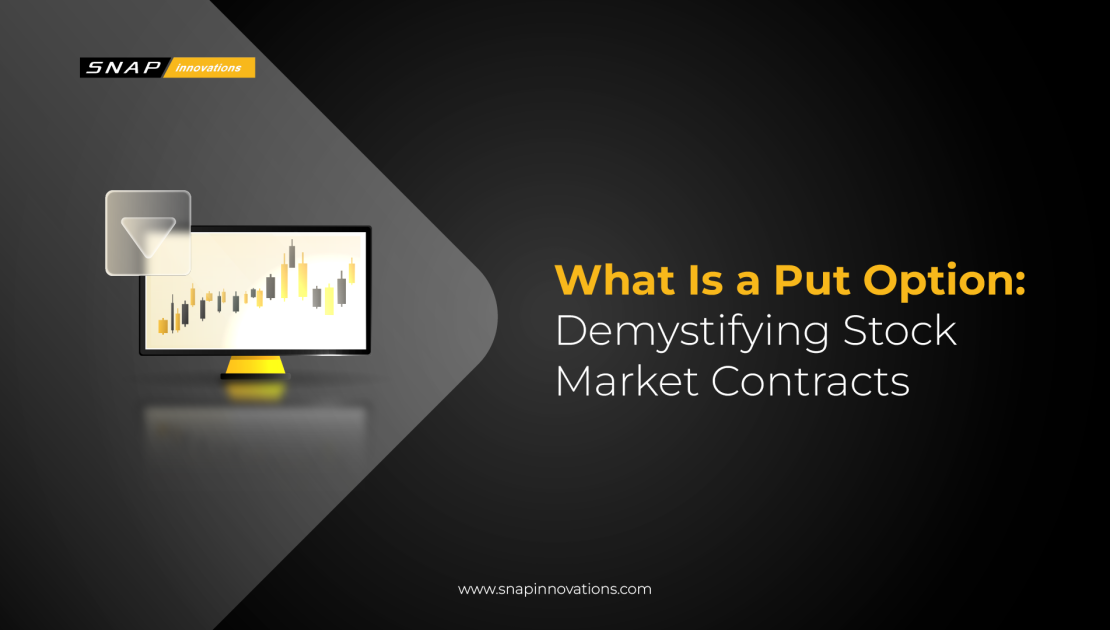In the dynamic realm of the stock market, various financial instruments provide traders and investors with opportunities to hedge risks, speculate on price movements, and diversify their portfolios. One such instrument is the put option, a versatile and essential contract that empowers individuals to navigate the complex landscape of stocks and securities.
In this comprehensive guide, we’ll delve into the intricacies of put options, unraveling their definition, functionality, and significance in the world of finance.
What Is a Put Option?
 Put options, often referred to simply as “puts,” are versatile financial instruments used in various trading and investment strategies. They offer flexibility and can be applied in multiple scenarios to manage risk or capitalize on market movements. For instance, one common strategy is known as “protective puts.” In this approach, investors who hold a long position in a particular stock may purchase put options to safeguard their investment against potential downturns in the stock’s price. If the stock’s value decreases, the put option gains value, offsetting some or all of the losses incurred in the stock position.
Put options, often referred to simply as “puts,” are versatile financial instruments used in various trading and investment strategies. They offer flexibility and can be applied in multiple scenarios to manage risk or capitalize on market movements. For instance, one common strategy is known as “protective puts.” In this approach, investors who hold a long position in a particular stock may purchase put options to safeguard their investment against potential downturns in the stock’s price. If the stock’s value decreases, the put option gains value, offsetting some or all of the losses incurred in the stock position.
Furthermore, put options can be employed for income generation through a strategy called “covered puts” or “cash-secured puts.” In this method, investors who are willing to purchase a specific stock at a predetermined price (the strike price) can sell put options on that stock. If the options expire worthless (i.e., the stock price remains above the strike price), the investor keeps the premium collected from selling the puts as profit. If the options are exercised and the stock is assigned, the investor acquires the stock at a lower price than the market, making it an attractive strategy for those looking to accumulate shares of a particular stock at a discount.
Moreover, put options are integral components of more complex strategies like spreads and combinations, which traders use to generate income or capitalize on market volatility. These strategies often involve simultaneous positions in both put and call options and can be tailored to specific market conditions and objectives. In summary, put options are valuable tools that empower investors to hedge their portfolios, generate income, and engage in sophisticated trading strategies. Their versatility and potential for risk management make them a fundamental aspect of the options market and a valuable resource for investors seeking to navigate the complexities of the financial markets.
How Do Put Options Work?
 To understand how put options work, let’s consider a hypothetical scenario. Imagine you are an investor who owns shares of a tech company, and you have concerns about the stock’s future performance due to upcoming industry changes. Let’s delve into the details of put options with an in-depth exploration of their key components and mechanics:
To understand how put options work, let’s consider a hypothetical scenario. Imagine you are an investor who owns shares of a tech company, and you have concerns about the stock’s future performance due to upcoming industry changes. Let’s delve into the details of put options with an in-depth exploration of their key components and mechanics:
1. Underlying Asset Selection
The first step in using put options effectively is selecting the appropriate underlying asset. Typically, put options are associated with individual stocks, but they can also be linked to other assets like indexes or exchange-traded funds (ETFs). Investors should consider their investment objectives, market outlook, and risk tolerance when choosing the underlying asset for their put options.
When selecting individual stocks, investors may focus on companies that they believe are overvalued, facing uncertain times, or expected to experience price declines. For example, if an investor anticipates a drop in the shares of a particular tech company due to weak earnings projections, they might consider purchasing put options on that stock.
2. Strike Price Considerations
The choice of the strike price is a crucial decision when trading put options. The strike price represents the level at which the option holder has the right to sell the underlying asset. There are various strike prices available for each underlying asset, typically at different intervals.
Investors should assess their market outlook and risk tolerance when selecting the strike price. If an investor expects a significant decline in the asset’s price, they may opt for a lower strike price, as it provides a greater opportunity for profit if the asset’s value falls substantially. Conversely, a higher strike price might be chosen for a more conservative approach.
Also Read: What is a Money Market Fund? Stability and Liquidity in Investments
3. Expiration Date Planning
The expiration date is another critical aspect of put options. It defines the period during which the option can be exercised. Expiration dates vary, and investors should choose one that aligns with their investment horizon and expectations for the asset’s price movement.
Short-term traders may prefer options with near-term expirations to capitalize on short-lived price declines, while longer-term investors might opt for options with extended expiration dates to hedge against potential declines over a more extended period.
4. Premium Assessment
The premium is the cost of purchasing a put option and is determined by various factors, including the underlying asset’s current price, the selected strike price, the time until expiration, market volatility, and interest rates. Assessing the premium is essential for understanding the potential risk and reward of the option trade.
Investors should evaluate whether the premium aligns with their risk appetite and return expectations. Lower premiums may offer a higher potential return but could require a more significant price decline in the underlying asset to be profitable. Higher premiums provide more protection but may require a more substantial price drop to justify the cost.
5. Holder’s Rights
Put options grant the holder the right, but not the obligation, to sell the underlying asset at the specified strike price. This right allows investors to benefit from a declining asset price without actually owning the asset. It provides flexibility and downside protection by limiting potential losses to the premium paid for the option.
Traders can profit from price declines in the underlying asset without having to take a short position or borrow the asset. This opens up a world of possibilities for investors looking to capitalize on market expectations, whether bearish or opportunistic.
6. Writer’s Obligations
On the flip side, the writer of a put option (also known as the seller) incurs certain obligations. If the option holder decides to exercise the put option, the writer must purchase the underlying asset at the strike price. This obligation can lead to potential losses for the writer if the asset’s price falls significantly.
Understanding the rights and obligations of put option holders and writers is essential for anyone considering trading or investing in these financial instruments. It empowers individuals to make informed decisions based on their financial goals, risk tolerance, and market expectations.
7. Risk Management Strategies
Investors often use put options as part of a broader risk management strategy. They may hold long positions in stocks or other assets while simultaneously purchasing put options to hedge against potential declines in those holdings. By doing so, they limit their downside risk while maintaining exposure to potential upside gains.
Additionally, traders can employ more complex options strategies, such as spreads or combinations, to customize their risk-reward profiles based on market conditions and their specific objectives.
Understanding these seven key aspects of put options provides investors with the knowledge and tools necessary to make informed decisions in the options market. Whether used for speculative purposes, portfolio protection, or risk management, put options are versatile instruments that can enhance an investor’s ability to navigate the complexities of the financial markets.
Key Terminology and Concepts of Put Option
 Before diving deeper into put options, it’s essential to familiarize yourself with key terminology and concepts associated with these contracts. Here are some fundamental terms you’ll encounter when dealing with put options:
Before diving deeper into put options, it’s essential to familiarize yourself with key terminology and concepts associated with these contracts. Here are some fundamental terms you’ll encounter when dealing with put options:
1. Put Option Premium
The premium of a put option is a reflection of various factors that influence its price. The primary components include the current market price of the underlying asset, known as the spot price, the option’s strike price, the time remaining until expiration, and prevailing interest rates.
These factors interact to determine the total premium paid by the option buyer to the option writer. When market conditions are characterized by increased uncertainty or higher volatility, put option premiums tend to be elevated, reflecting the potential for larger price swings in the underlying asset.
2. Strike Price
The strike price, also referred to as the exercise price, is a fundamental element of any put option contract. It precisely specifies the price at which the underlying asset can be sold by the put option holder upon exercising the option.
The choice of the strike price is a strategic decision for both buyers and sellers of put options. Put options are generally used when the option holder anticipates that the asset’s market price will fall below the strike price, resulting in a profitable exercise.
3. Expiration Date
The expiration date is a critical aspect of any put option, as it determines the time frame during which the option can be exercised. Put options come with various expiration dates, offering investors flexibility to align their positions with specific market expectations and timeframes.
Options with shorter expiration periods may be well-suited for traders looking to capitalize on short-term price movements, while longer-dated options provide a more extended window for market developments.
4. Intrinsic Value
Intrinsic value is a pivotal metric for evaluating the true worth of a put option at any given time. In the context of put options, intrinsic value is calculated as the difference between the strike price and the current market price of the underlying asset. When the intrinsic value is positive, indicating that the market price is below the strike price, the option is considered “in the money” (ITM).
It signifies that if the option were exercised immediately, it would result in a profit for the holder. On the other hand, when intrinsic value is zero or negative, the option is “out of the money” (OTM).
5. Time Value
Time value, also known as extrinsic value, plays a pivotal role in the pricing and trading of put options. It represents the portion of the option premium that is not attributed to intrinsic value. Instead, it is associated with the potential for the option’s value to increase before its expiration due to various factors.
These factors include changes in implied volatility and the passage of time. Time value can significantly impact the overall option premium, making it a critical consideration for traders.
6. Implied Volatility
Implied volatility (IV) is a key determinant of option prices and a critical factor in assessing risk. It measures the market’s expectations regarding future price fluctuations of the underlying asset. When implied volatility is high, it often corresponds to elevated option premiums.
Traders and investors monitor implied volatility to gauge market sentiment, assess the level of perceived risk, and make informed trading decisions. A higher IV indicates greater expected price volatility.
7. Time Decay (Theta)
Time decay, represented by the Greek letter theta, is an essential concept for option holders to grasp. It quantifies the rate at which an option’s value erodes as it approaches its expiration date. Time decay primarily affects the extrinsic value of the option, reducing it over time.
As an option gets closer to expiration, time decay accelerates. This phenomenon underscores the importance of careful timing and strategic decision-making for option holders to maximize profitability.
Understanding these key terms and concepts empowers traders and investors to navigate the complexities of put options effectively. By grasping the nuances of option premiums, strike prices, expiration dates, intrinsic and time values, implied volatility, and time decay, individuals can make informed choices, construct strategic positions, and manage risk when participating in the dynamic world of stock market contracts.
Strategies for Using Put Options
One of the most common applications is hedging against downside risk, where investors use put options to safeguard their portfolios from adverse price movements. By purchasing put options on individual stocks or broad market indices, investors can mitigate potential losses in the event of a market downturn, providing a level of insurance for their investments.
Speculative trading is another avenue where put options come into play. Traders with a bearish outlook on a particular stock or market segment can profit from anticipated price declines. They can achieve this by either buying put options outright or implementing more complex strategies such as bear spreads or ratio spreads. These strategies allow traders to potentially profit from falling prices, providing an alternative to short selling, which carries unlimited risk.
Income generation through cash-secured puts involves committing to purchase a stock at a lower price while receiving an upfront premium. In this strategy, an investor is willing to buy a stock at a predetermined strike price, which is typically below the current market price. By doing so, they receive a premium from the put option seller. If the stock price remains above the strike price, they keep the premium as profit without actually acquiring the stock.
Investors also use put options to protect their long positions. When holding a stock they believe will appreciate over time, they can purchase put options as insurance against unexpected market declines. If the stock’s price falls significantly, the gains from the put options can offset the losses in the stock, limiting the overall downside risk.
Risks and Considerations of using Put Option
Put options, despite their versatility and potential for profit, come with a set of inherent risks and considerations that warrant a comprehensive understanding. These financial instruments possess a limited lifespan, which means that if market conditions do not align with the investor’s predictions within the specified timeframe, they could potentially lose the premium paid for the option. Additionally, the unpredictable nature of market volatility can lead to unexpected losses, making it crucial for investors to carefully assess their risk tolerance before engaging in put option trading. It’s also essential to grasp the concept of the “theta” effect, where the value of options erodes gradually over time, influencing decision-making regarding the timing of option execution.
Also Read: 7 Types of Candlestick Patterns You Should Know
Selecting the appropriate underlying asset is a pivotal aspect of successful put option trading. Illiquidity in certain assets can affect the execution process, potentially leading to higher costs and less favorable outcomes. The complexity associated with put options necessitates a solid grasp of various variables, including strike prices and implied volatility, which can impact the pricing and potential profitability of the options. Furthermore, for those who choose to write put options, there are margin requirements and assignment risk to contend with, which can significantly affect the overall financial picture.
Moreover, holding put options through earnings announcements can be particularly risky, as price movements during such events can be highly unpredictable and result in substantial losses. It is imperative for investors to stay informed about regulatory changes, as shifts in regulations can have a significant impact on options trading. In light of these multifaceted considerations, individuals interested in put option trading should prioritize thorough education, potentially seek professional advice, and ensure that their utilization of put options aligns with their broader financial goals and risk tolerance. It is a financial strategy that offers opportunities for profit but necessitates a meticulous and well-informed approach to mitigate potential downsides effectively.
Conclusion
In the dynamic world of the stock market, understanding the intricacies of put options can be a valuable asset for both seasoned investors and newcomers. These versatile contracts offer a range of strategies to protect against downside risk, profit from price declines, or maintain a balanced portfolio.
While they come with their own set of complexities and risks, put options serve as indispensable tools in the toolkit of anyone looking to navigate the stock market with confidence and strategy. Whether you’re an investor or a trader, the knowledge of what a put option is and how it operates can empower you to make informed financial decisions and seize opportunities in the ever-evolving world of finance.


